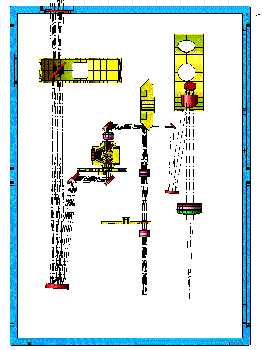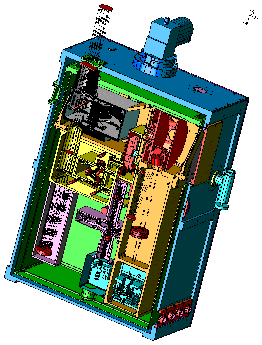 Three basic sections make up the cold optics: the fore-optics.
the infrared slit-viewer, and the spectrograph.
Three basic sections make up the cold optics: the fore-optics.
the infrared slit-viewer, and the spectrograph.
 An IRTF-designed
array controller
will run both the spectrograph
and imaging arrays. Cryostat-mounted electronics, consisting
of pre-amps, A/Ds, clock, and bias boards, are fiber optically
coupled to the array controller, which resides in the telescope control
room. The VME64-based array controller uses multiple DSPs,
and a single-board computer. A smaller instrument computer
mounted on the mirror cell, is used for motor and temperature
control, and for monitoring tasks. The user interface
runs on a Unix workstation connected to the array controller
and instrument computer by Ethernet. See
Systems Interconnection diagram.
An IRTF-designed
array controller
will run both the spectrograph
and imaging arrays. Cryostat-mounted electronics, consisting
of pre-amps, A/Ds, clock, and bias boards, are fiber optically
coupled to the array controller, which resides in the telescope control
room. The VME64-based array controller uses multiple DSPs,
and a single-board computer. A smaller instrument computer
mounted on the mirror cell, is used for motor and temperature
control, and for monitoring tasks. The user interface
runs on a Unix workstation connected to the array controller
and instrument computer by Ethernet. See
Systems Interconnection diagram.
The cryostat is mounted to the telescope by a rigid interface box, into which is built a spectral calibration unit consisting of optics, integrating sphere, flat-field lamps, and spectral lamps. The cryostat vacuum jacket is an e-beam welded aluminum box measuring 112cm x 79cm x 61cm. Cooling is accomplished by attaching the first stage of a CTI 1050 cryo-cooler to a cold shield . The cold shield sinks most of the radiation load from the large vacuum jacket. A liquid nitrogen vessel sinks the remainder of the load and clamps the temperature of the optics box. The second stage of the cooler provides cooling to the two detectors, which are servoed to operate at 35K. Rigidity between the inside and outside of the cryostat is maintained by attaching the cold optics mounting plate to the thick top plate of the vacuum jacket by four V-shaped G-10 fiber-glass trusses. Relative flexure between the internal optics is minimized by mounting them into boxes attached to the common mounting plate. SpeX contains seven cryogenic mechanisms. These are controlled using warm motors and vacuum feed-throughs.
 Three basic sections make up the cold optics: the fore-optics.
the infrared slit-viewer, and the spectrograph.
Three basic sections make up the cold optics: the fore-optics.
the infrared slit-viewer, and the spectrograph.
In the fore-optics, the f/38.2 beam entering the cryostat first encounters a dichroic turret before coming to a focus. Visible reflecting/infrared transmitting dichroics feed a visible beam to the tip-tilt sensor package mounted on the side of the cryostat. This package will be provided by IRTF. The optical path following the cold telescope focus comprises a collimating mirror, 12.5 mm cold stop, filter wheel, k-mirror image rotator, and camera lens. This system reimages a 60x60 arcsec field onto a slit wheel and feeds an f/12.6 beam into the spectrograph.
The field surrounding the slit is reflected into the slit-viewer, which consists of collimating lens, cold stop, filter wheel, camera lens, and array. If a 512x512 InSb array is employed as planned, then the 60x60 arcsec field is sampled at 0.12 arcsec/pixel. In addition to object acquisition and scientific imaging, the slit-viewer can be used for infrared guiding in areas of the sky where the optical tip-tilt system lacks suitable guide stars. We are investigating its potential use as a fast-guider for tip-tilt.
The f/12.6 beam entering the spectrograph is first collimated by an off-axis parabola. The collimator forms a 24 mm diameter image of the telescope pupil on a grating/prism mounted in a turret wheel. Following dispersion, a camera lens images the spectrum onto the 1024x1024 InSb array, with a spatial scale of 0.15 arcsec/pixel. Because of the wide wavelength range, cross-dispersion is done with prisms, which are used in double-pass mode. To keep the spacing of the cross-dispersed orders equal, which is essential to maximize slit length, different prism materials are used. A Fused Silica/ZnSe dual-prism is used in the 0.8-2.5 micron mode, and a LiF/Germanium dual-prism is used in the 2.0-5.5 micron mode. All the lenses are BaF2-LiF-ZnS achromatic triplets.
A full (but provisional) list of dichroics, filters, slits, and grating turret positions is given here.
A quick-look data reduction software package will be provided for observers at the telescope. Unlike infrared imaging and high-resolution spectroscopy where simple sky subtraction is is usually sufficient to reveal features of interest, medium-resolution spectroscopy requires at least first-order removal of telluric effects to reveal spectral features in the object. Quick-look data reduction will provide near-real-time flat fielding and telluric cancellation. This will allow observers to check the quality of their data and adjust their observing procedures when necessary.